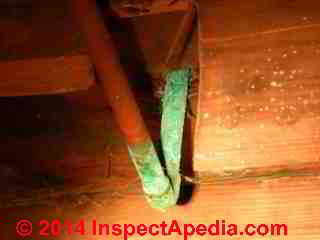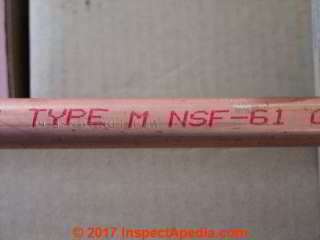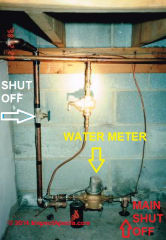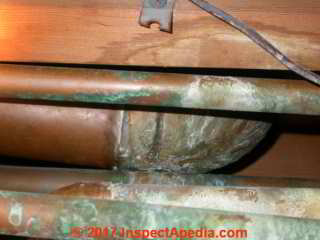 Inspect Pipes for Corrosion-Leaks
Inspect Pipes for Corrosion-Leaks
How to detect points of leakage in supply & drain pipes
- POST a QUESTION or COMMENT about this article topic.
Spot leak points in copper piipes caused by aggressive, corrosive, low pH water - acidic water:
This article describes inspection points to find leaks or corrosion and pitting in copper water supply or copper drain piping in buildings.
This article series describes effects of low pH, acidic or corrosive water on building piping, leaks, dissolved copper, health hazards, and the plumbing system in general.
InspectAPedia tolerates no conflicts of interest. We have no relationship with advertisers, products, or services discussed at this website.
- Daniel Friedman, Publisher/Editor/Author - See WHO ARE WE?
Inspect copper piping for leaks, corrosion, pinholes & leak risk factors

As we note at CORROSIVITY or ACIDITY of WATER, corrosive water is responsible for health effects of increased lead, copper or other contaminants in drinking water and corrosive water in building plumbing & heating systems is also responsible for costly leak damage.
Here are some inspection points that help find corrosion-induced leaks in copper supply and drain pipes in buildings.
- Identify the copper pipe type: First, what quality of copper has been installed? Copper piping is sold in different weights or thicknesses.
M is thin-walled, used in heating baseboards (you should be ok with that as the water in a hot water heating system does not keep changing out so corrosivity is normally limited);
Types K (thickest) and L copper are used for water piping, M being the heavier grade, more resistant to corrosion perforation. - Inspect both water supply pipes and copper waste pipes too. Pinhole leaks in copper pipes can occur on both supply and drain piping.
Corrosive water combined with waste and waste water increases the risk of corroding copper drain piping. Pinholes can form anywhere on copper water supply piping.
Drain pipe leaks in copper pipes, if caused by corrosion, form differently. Surprisingly you need to look along low-sloping runs of copper drain piping for evidence of corrosion or leaks along the top of the copper drain pipe, not just the bottom.That's because droplets of highly corrosive condensate form along the upper surface of the pipes and remain in place for long periods, never being washed away by drain usage.
- Test the corrosivity of the water supply. Beginning at CORROSIVITY or ACIDITY of WATER we explain that corrosive water increases the chance of leaks in copper piping.
- Look for blue dots or pinholes along the copper pipe surfaces: For all copper pipes, but particularly if your distribution piping is Type L, you should inspect for corrosion on the pipe exterior - and beware that a small blue dot, when you scratch it, may become a rapid leak.
Because the piping is corroding from the interior out, you won't see how thin and fragile other piping sections are ... until the next leak.
Watch out: Don't ever "pick" at corrosion on water pipes, water tanks, heating boilers, water heaters, calorifiers, cylinders: unless you're prepared to shut down the water supply and clean up a leak.
- Look for larger areas of corroded piping such as that shown in our photograph at the top of this page and in our photograph just above.
More likely the thick green copper-oxide on the copper pipe in the page top photo is from a larger leak on the other side of the subfloor through which the pipe is passing.
In the photo just above leaks at a bathroom toilet have stained the subfloor and both supply and drain pipes in this New Jersey surgical center. These are external corrosion and leak signs rather than signs of leaks caused by internal corrosion of the pipes.
- Look for signs of active leaks: water stains on building materials below the piping or in severe cases, wet lengths of piping or wet building surfaces near or below the pipes.
Watch out: don't confuse condensation on water pipes with leaks. Our photo shows condensation on cold water supply pipes in a damp crawl space.
See CONDENSATION or SWEATING PIPES, TANKS for details. - Replace leaky copper piping: The bad news that has come up with some InspectAPedia readers, is that if you discover a length of copper piping with imminent or current pinholes, replacing just that section is not very comforting.
Other Causes of Pinhole Leaks in Copper Pipes in Buildings

Other causes of copper pipe pinholing or holing and leaks include
- Galvanic corrosion -
see GALVANIC SCALE & METAL CORROSION - Scouring of the pipe interior by unusually high velocity water flow through the system.
- Sand, silt, or other abrasive contaminants in the water supply (you will probably detect these by clogged strainers at your faucets or clogged shower heads),
- Improper or missing electrical grounding of the electrical equipment or any other electrical appliances in the building, including the presence of stray voltage in the grounding system or poor bonding of the grounding conductors to metal piping, or its interruption
by DIELECTRIC FITTING CODES or other components.
More about leaks in water systems, heating, air conditioning, or other mechanical systems traced to improper grounding is
at PINHOLE LEAKS by ELECTRICAL GROUND ERRORS.
"Bonding" means that the metallic parts are permanently joined to form an electrically conductive path ... to reliably conduct electrical current.
"Grounding" refers to the connection of an electrical circuit or component to the earth. - Roberge (1999) & NEC Article 100
&
DEFINITIONS of ELECTRICAL TERMS
We discuss corrosion due to electrical grounding system errors in more detail
at ELECTRICAL GROUND PIPE CORROSION just below. - Lightning strikes or electrical arcing from nearby electrical components - as I describe just below
We joined in investigating a site that had suffered what appeared to be a lightning strike - it was actually an electrical discharge from a high voltage power transmission line. A tree grew tall enough to contact the line, conducting power to the ground close to the home.
Moisture under the garage floor slab vaporized, exploding the floor, sending the car up through the garage roof.
Electricity traveled across from the garage, apparently following tree roots, up an iron entry stair railing, over to aluminum siding (all the aluminum pop rivets melted and all of the the siding corner trim pieces fell to the ground), around the siding to a metal outdoor hose bib to metal water piping.
Inside the building the water pipe was fused and melted, causing a basement flood.
...
Reader Comments, Questions & Answers About The Article Above
Below you will find questions and answers previously posted on this page at its page bottom reader comment box.
Reader Q&A - also see RECOMMENDED ARTICLES & FAQs
On 2017-02-20 by Pete - copper water pipes develop pin hole leaks ?
do copper water pipes develop pin hole leaks over time?
Moderator reply:
Yes possibly, Pete if the water itself is corrosive. But there can be other causes of pinhole leaks in copper pipes or tubing. See
- OTHER CAUSES of PINHOLE LEAKS in COPPER PIPES
- OTHER CAUSES of PIPE PITTING: pH & HCO3 LEVELS
- PINHOLE LEAKS by ELECTRICAL GROUND ERRORS
...
Continue reading at OTHER CAUSES of PIPE PITTING: pH & HCO3 LEVELS or select a topic from the closely-related articles below, or see the complete ARTICLE INDEX.
Or see these
Recommended Articles
- CORROSIVITY or ACIDITY of WATER
- CORROSIVITY PROBLEMS in WATER SYSTEMS
- CAUSES of CORROSIVE WATER
- COPPER IN WATER, HEALTH EFFECTS
- pH of DRINKING WATER, HEALTH EFFECTS
- LANGLIER SATURATION INDEX LSI
- LEAD IN DRINKING WATER, HOW to REDUCE
- LEAK INSPECTION of WATER SYSTEMS
- OTHER CAUSES of PINHOLE LEAKS in COPPER PIPES
- OTHER CAUSES of PIPE PITTING: pH & HCO3 LEVELS
- PINHOLE LEAKS by ELECTRICAL GROUND ERRORS
- LEAK CAUSES in WATER PIPING
- WATER TREATMENT EQUIPMENT CHOICES - home
Suggested citation for this web page
LEAK INSPECTION of WATER SYSTEMS at InspectApedia.com - online encyclopedia of building & environmental inspection, testing, diagnosis, repair, & problem prevention advice.
Or see this
INDEX to RELATED ARTICLES: ARTICLE INDEX to WATER TREATMENT SYSTEMS
Or use the SEARCH BOX found below to Ask a Question or Search InspectApedia
Ask a Question or Search InspectApedia
Try the search box just below, or if you prefer, post a question or comment in the Comments box below and we will respond promptly.
Search the InspectApedia website
Note: appearance of your Comment below may be delayed: if your comment contains an image, photograph, web link, or text that looks to the software as if it might be a web link, your posting will appear after it has been approved by a moderator. Apologies for the delay.
Only one image can be added per comment but you can post as many comments, and therefore images, as you like.
You will not receive a notification when a response to your question has been posted.
Please bookmark this page to make it easy for you to check back for our response.
IF above you see "Comment Form is loading comments..." then COMMENT BOX - countable.ca / bawkbox.com IS NOT WORKING.
In any case you are welcome to send an email directly to us at InspectApedia.com at editor@inspectApedia.com
We'll reply to you directly. Please help us help you by noting, in your email, the URL of the InspectApedia page where you wanted to comment.
Citations & References
In addition to any citations in the article above, a full list is available on request.
- De Waard, C., and D. E. Milliams. "Carbonic acid corrosion of steel." Corrosion 31, no. 5 (1975): 177-181.
- Isaac, R. A., L. Gil, A. N. Cooperman, K. Hulme, B. Eddy, M. Ruiz, K. Jacobson, C. Larson, and O. C. Pancorbo. "Corrosion in drinking water distribution systems: a major contributor of copper and lead to wastewaters and effluents." Environmental science & technology 31, no. 11 (1997): 3198-3203.
- Jones, Anne. "Stress corrosion cracking." In in ASM Handbook, Metals Handbook. 1998.
- Kermani, M. B., and A. Morshed. "Carbon dioxide corrosion in oil and gas production—a compendium." Corrosion 59, no. 8 (2003): 659-683.
- Kiene, L., W. Lu, and Y. Levi. "Relative importance of the phenomena responsible for chlorine decay in drinking water distribution systems." Water Science and Technology 38, no. 6 (1998): 219-227.
- Kritzer, Peter. "Corrosion in high-temperature and supercritical water and aqueous solutions: a review." The Journal of Supercritical Fluids 29, no. 1 (2004): 1-29.
- Little, Brenda J., Florian B. Mansfeld, Peggy J. Arps, and James C. Earthman. Microbiologically influenced corrosion. Wiley‐VCH Verlag GmbH & Co. KGaA, 2007.
- Oram, Brian, "Drinking Water Issues Corrosive Water (Lead, Copper, Aluminum, Zinc, and More)" (web page), Water Research Center, Water Research Center B.F. Environmental Consultants Inc. 15 Hillcrest Drive, Dallas, PA 18612, USA, retrieved 2017/02/16, original source: http://www.water-research.net/index.php/drinking-water-issues-corrosive-water-lead-copper-aluminum-zinc-and-more
- Roberge, P. R. (1999). Handbook of Corrosion Engineering (1st ed.). McGraw-Hill Professional. ISBN 0-07-076516-2.
- Sigler, W. Adam, and Bauder, Jim, "CORROSIVITY" [PDF], Montana State University Extension, Water Quality Program, Department of Land Resources and Environmental Sciences, (un-dated) retrieved 2017/02/16, original source: http://waterquality.montana.edu/well-ed/files-images/Corrosivity.pdf - note that this page was adapted from Wilkes University Center For Environmental Quality; Corrosion, Saturation Index, Balanced Water in Drinking Water Systems
- Speller, Corrosion. Causes and Prevention of Corrosion in Steam and Hot Water Heating Systems. McGraw-Hill, 1951.
- Volk, Christian, Esther Dundore, John Schiermann, and Mark LeChevallier. "Practical evaluation of iron corrosion control in a drinking water distribution system." Water research 34, no. 6 (2000): 1967-1974.
- Was, G. S., P. Ampornrat, G. Gupta, S. Teysseyre, E. A. West, T. R. Allen, K. Sridharan et al. "Corrosion and stress corrosion cracking in supercritical water." Journal of Nuclear Materials 371, no. 1 (2007): 176-201.
- [2] Clean Water Systems & Stores, Inc. 2806-A Soquel Ave, Santa Cruz, California 95062, Telephone: 1-888-600-5426 or international: 1-831-462-8500 . web search 4/23/12, original source: - cleanwaterstore.com/copper-pipe-corrosion.html
- [3] "pH in Drinking-water Background document for development of WHO Guidelines for Drinking-water Quality", in Guidelines for drinking-water quality, 2nd ed. Vol. 2. Health criteria and other supporting information, World Health Organization, Geneva, 1996. Web search 4/23/12, original source: http://www.who.int/water_sanitation_health/dwq/chemicals/en/ph.pdf
- [4] "Langelier Saturation Index (LSI), Wikipedia Web: https://www.wikipedia.org/ provided background information about some topics discussed at this website provided this citation is also found in the same article along with a " retrieved on" date. NOTE: because Wikipedia entries are fluid and can be amended in real time, we cite the retrieval date of Wikipedia citations and we do not assert that the information found there is necessarily authoritative.
- [5] "Drinking Water Contaminants, List of Contaminants & their MCLs", U.S. EPA United States Environmental Protection Agency, National Primary Drinking Water Regulations, web search 4/23/12, original source: http://water.epa.gov/drink/contaminants/index.cfm#List
- [6] "Basic Information about Copper in Drinking Water", U.S. EPA United States Environmental Protection Agency, web search 4/23/12, original source: http://water.epa.gov/drink/contaminants/basicinformation/copper.cfm
- [7] "Fin Tube / Bare Elements", Slant/Fin Boilers & Baseboards, Slant/Fin Corporation, 100 Forest Drive, Greenvale, NY 11548, Phone: (516) 484-2600, Fax: (516) 484-5921, E-mail: info@slantfin.com, web search 4/23/12, original source: http://www.slantfin.com/index.php/products/baseboard-residential/fin-tube--bare-elements
- ABS Plastic Drain/Waste/Vent (DWV) pipe failures: reported for Centaur, Phoenix, Polaris, Gable, and Spartan pipe mfgs. for pipe made between 1985 and 1988. CPSC Hot Line: 800-638-8270 or ABS Drain Leaks/Failures-Class Action Settlement COX settlement through Shell Oil set up by a contractor involved in the settlement. Polybutylene Plumbing Failures: Spencer Class settlement, Web: spencerclass.com, 10% of replacement cost/damages, only for acetal (plastic)fittings Polybutylene plumbing lawsuit proposed settlement-old site
- [12] Compression fittings for plumbing connections, Wikipedia photograph, web search 08/09/2010, original source: http://en.wikipedia.org/wiki/File:Robinetterie-raccords.JPG
- [13] "Guidelines for drinking-water quality", 2nd ed. Vol. 2. Health criteria and other supporting information. World Health Organization, Geneva, 1996. WHO, op.cit.
- [14] "Pitting Corrosion in Copper Tubes – Cause of Corrosion and Counter-Measures", Mattsson, E.; Fredriksson, A.-M., British Corrosion Journal, Volume 3, Number 5, September 1968 , pp. 246-257(12), Maney Publishing, Quoting the article abstract:
An investigation of failures of hard-drawn copper water pipes (phosphorus-deoxidised copper) in service due to pitting corrosion was conducted from November, 1962 to February, 1965. Fifteen cases were reported. All those about which information could be obtained came from hot water installations and occurred in water with a low pH (?7) and a HCO3- content of, at the most, 100 mg/l but generally below 50 mg/1. Failures not due to pitting corrosion (i.e. caused by erosion and corrosion or corrosion fatigue) occurred in waters with a higher pH and higher HCO3- content.
A laboratory investigation into the ability of the corrosion products to counteract further corrosion in different types of water was also carried out, using an electrolytic cell which, in principle, was a model of an active pit in a copper tube. This led to the following conclusions, which are in good agreement with the results obtained from the examination of service failures:
If the pH value of the water is high enough, the copper dissolved by the corrosion can be precipitated as basic copper salt. At low pH values such precipitation does not take place.
If the [HCO3?]/[SO42?] ratio in the water is high, dissolved copper can be precipitated as basic copper carbonate in the neighbourhood of the corrosion site and counteract further corrosion.
At a low [HCO3?]/[SO42?] ratio, crusts of basic copper sulphate will be precipitated at some distance from the corrosion site and may lead to a high corrosion rate.
Pitting is not likely to occur in hot water tubes of hard copper if the pH is ? 7·4 and the [HCO3?]/[SO42?] ratio ?1 (the concentrations given in mg/1). The critical values mentioned are approximate and may be adjusted in the light of future experience. - [15] "Health and aesthetic impacts of copper corrosion on drinking water",
Dietrich AM, Glindemann D, Pizarro F, Gidi V, Olivares M, Araya M, Camper A, Duncan S, Dwyer S, Whelton AJ, Younos T, Subramanian S, Burlingame GA, Khiari D, Edwards M., Virginia Tech, Blacksburg, VA 24061-0246, USA. andread@vt.edu, Water Sci Technol. 2004;49(2):55-62., Abstract
Traditional research has focused on the visible effects of corrosion--failures, leaks, and financial debits--and often overlooked the more hidden health and aesthetic aspects. Clearly, corrosion of copper pipe can lead to levels of copper in the drinking water that exceed health guidelines and cause bitter or metallic tasting water. Because water will continue to be conveyed to consumers worldwide through metal pipes, the water industry has to consider both the effects of water quality on corrosion and the effects of corrosion on water quality. Integrating four key factors--chemical/biological causes, economics, health and aesthetics--is critical for managing the distribution system to produce safe water that consumers will use with confidence. As technological developments improve copper pipes to minimize scaling and corrosion, it is essential to consider the health and aesthetic effects on an equal plane with chemical/biological causes and economics to produce water that is acceptable for public consumption.
Other water supply and drain piping and water pressure articles:
- Clogged Drain Diagnosis: Is it a blocked drain or the septic system? - A First Step for Homeowners
- CROSS CONNECTIONS, PLUMBING - bacterial contamination of building piping - sources
- Plastic Water Supply & Drain Piping Failures, Leaks, Repairs, Lawsuits: Water Supply Piping Defects and Plastic or polybutylene water supply piping failures, leaks, and litigation.
- PLASTIC PIPING ABS CPVC PB PEX PPR PVC - Leaks, Repairs, Lawsuits: Water Supply Piping Defects and Plastic or polybutylene water supply piping failures, leaks, and litigation. Our main article on plastic supply and drain piping leaks, failures, litigation, repairs, at PLASTIC PIPING ABS CPVC PB PEX PPR PVC. Excerpts are just below.
- PB (polybutylene with mechanical fittings) Piping leaks: especially in mobile homes and in the U.S. South, for example trailers and double-wides throughout Florida that were piped with this material - per M Cramer. See "Polybutylene Piping: Time Bomb?" Daniel Friedman, Journal of Light Construction, August 1996 [Technical Q&A] .
- Plastic Supply and Drain Piping Failures: leaks, lawsuits, settlements
- If plastic water piping is installed, such as polybutylene water supply piping, it should be at least 18" from the water heater.
- New mobile home and trailer units: 3/4" supply piping, min 6" off ground; shutoff valve required;
- TRANSITE PIPE WATER SUPPLY PIPING - what are the health hazards and other risks from cement asbestos (transite) water pipes?ir
- WATER PUMP PRESSURE SWITCH NUT ADJUSTMENTS how to adjust the water pressure in a building
- Water Pressure Loss - Diagnosis how to determine why water pressure has been lost or why there is no water at all in a building
- Water Testing for contaminants in drinking water - what test are available, what tests to ask for, what they cost, how people cheat on water tests
- Wells, Cisterns,& Springs types of sources of drinking water, what they look like, what goes wrong, what to do about itWATER PRESSURE LOSS how to diagnose the cause of bad water pressure
- WATER PRESSURE BOOSTING how to install a system to increase water pressure at a building
- WINTERIZE A BUILDING: how to freeze-proof plumbing in a building, how to avoid freezing pipes, how to thaw frozen pipes: how to winterize a building against freezing and frost damage.
- Our recommended books about building & mechanical systems design, inspection, problem diagnosis, and repair, and about indoor environment and IAQ testing, diagnosis, and cleanup are at the InspectAPedia Bookstore. Also see our Book Reviews - InspectAPedia.
- In addition to citations & references found in this article, see the research citations given at the end of the related articles found at our suggested
CONTINUE READING or RECOMMENDED ARTICLES.
- Carson, Dunlop & Associates Ltd., 120 Carlton Street Suite 407, Toronto ON M5A 4K2. Tel: (416) 964-9415 1-800-268-7070 Email: info@carsondunlop.com. Alan Carson is a past president of ASHI, the American Society of Home Inspectors.
Thanks to Alan Carson and Bob Dunlop, for permission for InspectAPedia to use text excerpts from The HOME REFERENCE BOOK - the Encyclopedia of Homes and to use illustrations from The ILLUSTRATED HOME .
Carson Dunlop Associates provides extensive home inspection education and report writing material. In gratitude we provide links to tsome Carson Dunlop Associates products and services.



